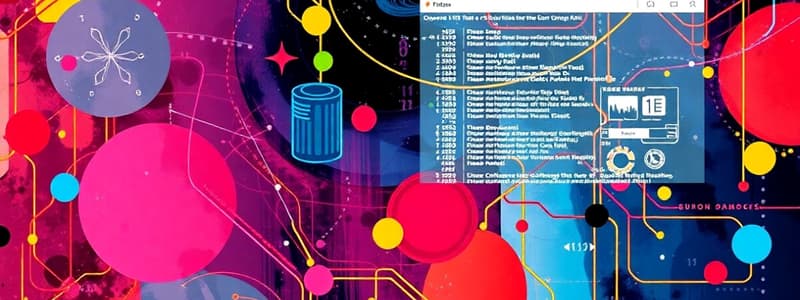Podcast
Questions and Answers
What type of operating system allows multiple users to perform multiple tasks concurrently?
What type of operating system allows multiple users to perform multiple tasks concurrently?
- Batch Operating System
- Network Operating System
- Real-Time Operating System
- Multi-tasking Operating System (correct)
Which operating system is characterized by its ability to treat multiple CPUs as one centralized system?
Which operating system is characterized by its ability to treat multiple CPUs as one centralized system?
- Real-Time Operating System
- Multi-processing Operating System
- Distributed Operating System (correct)
- Network Operating System
Which of the following is NOT a characteristic of a Non-pre-emptive Multi-Tasking Operating System?
Which of the following is NOT a characteristic of a Non-pre-emptive Multi-Tasking Operating System?
- Enables cooperative multitasking
- Allows context switching (correct)
- Is commonly found in UNIX systems
- Cannot initiate context switches
Which mobile operating system is known for powering wearables?
Which mobile operating system is known for powering wearables?
In what type of operating system does the system respond and process inputs in extremely small time intervals?
In what type of operating system does the system respond and process inputs in extremely small time intervals?
What is the primary function of a Network Operating System?
What is the primary function of a Network Operating System?
Which type of operating system is known for its ability to enhance the throughput by utilizing more than one CPU?
Which type of operating system is known for its ability to enhance the throughput by utilizing more than one CPU?
Which of these systems is designed exclusively for executing tasks in organized groups?
Which of these systems is designed exclusively for executing tasks in organized groups?
What is a group of eight bits commonly called?
What is a group of eight bits commonly called?
Which section in assembly language is used for declaring variables?
Which section in assembly language is used for declaring variables?
What programming language was used to develop the Apollo Guidance Computer's software?
What programming language was used to develop the Apollo Guidance Computer's software?
What is the primary purpose of using bits in networking?
What is the primary purpose of using bits in networking?
Which of these features is not part of the Menuet OS?
Which of these features is not part of the Menuet OS?
Which assembly language register is mainly used for arithmetic operations?
Which assembly language register is mainly used for arithmetic operations?
What function does the syscall 'int 0x80' perform?
What function does the syscall 'int 0x80' perform?
When was the Visible Calculator (VISICAL C) first released?
When was the Visible Calculator (VISICAL C) first released?
Who is credited with the development of the first assembler language?
Who is credited with the development of the first assembler language?
What is the ASCII code for the uppercase letter A?
What is the ASCII code for the uppercase letter A?
Unicode provides codes for how many characters?
Unicode provides codes for how many characters?
What is the main feature of UTF-8 encoding?
What is the main feature of UTF-8 encoding?
What type of data is commonly referred to as 'text'?
What type of data is commonly referred to as 'text'?
What is the purpose of a time-sharing operating system?
What is the purpose of a time-sharing operating system?
What is the primary purpose of ASCII codes?
What is the primary purpose of ASCII codes?
How many bits does Unicode primarily use to represent characters?
How many bits does Unicode primarily use to represent characters?
Which of the following best describes digitization?
Which of the following best describes digitization?
What type of file is often referred to as 'Plain Text' on Apple devices?
What type of file is often referred to as 'Plain Text' on Apple devices?
What does the binary number system consist of?
What does the binary number system consist of?
Which operating system was first introduced in 1972 and is still in use today?
Which operating system was first introduced in 1972 and is still in use today?
In the context of assembly language programming, what is its primary purpose?
In the context of assembly language programming, what is its primary purpose?
What is the most significant characteristic of the digital revolution?
What is the most significant characteristic of the digital revolution?
What does the term 'bit' stand for?
What does the term 'bit' stand for?
Which feature do Windows Terminal Services provide?
Which feature do Windows Terminal Services provide?
Flashcards
Character Data
Character Data
A sequence of characters, including letters, symbols, and numerals, used to represent text.
ASCII
ASCII
A standard code for representing characters used in computers and other devices. It assigns a unique numerical value to each character, including letters, numbers, and punctuation marks.
Unicode
Unicode
A coding scheme that allows for a greater variety of characters than ASCII, including characters from different languages and symbols.
UTF-8
UTF-8
Signup and view all the flashcards
Assembler Language
Assembler Language
Signup and view all the flashcards
Kathleen Booth
Kathleen Booth
Signup and view all the flashcards
Von Neumann Architecture
Von Neumann Architecture
Signup and view all the flashcards
Unformatted Text
Unformatted Text
Signup and view all the flashcards
Time-Sharing Operating System
Time-Sharing Operating System
Signup and view all the flashcards
Digitization
Digitization
Signup and view all the flashcards
Digital Revolution
Digital Revolution
Signup and view all the flashcards
Binary Number System
Binary Number System
Signup and view all the flashcards
Numeric Data
Numeric Data
Signup and view all the flashcards
Virtual Machine Environment
Virtual Machine Environment
Signup and view all the flashcards
Windows Terminal Services
Windows Terminal Services
Signup and view all the flashcards
Batch Operating System
Batch Operating System
Signup and view all the flashcards
Multi-tasking Operating System
Multi-tasking Operating System
Signup and view all the flashcards
Pre-emptive Multi-Tasking OS
Pre-emptive Multi-Tasking OS
Signup and view all the flashcards
Non-pre-emptive Multi-Tasking OS
Non-pre-emptive Multi-Tasking OS
Signup and view all the flashcards
Multi-Processing Operating System
Multi-Processing Operating System
Signup and view all the flashcards
Distributed Operating System
Distributed Operating System
Signup and view all the flashcards
Network Operating System
Network Operating System
Signup and view all the flashcards
Real-Time Operating System
Real-Time Operating System
Signup and view all the flashcards
Byte
Byte
Signup and view all the flashcards
Bit
Bit
Signup and view all the flashcards
Text Section
Text Section
Signup and view all the flashcards
Data Section
Data Section
Signup and view all the flashcards
BSS Section
BSS Section
Signup and view all the flashcards
EAX Register
EAX Register
Signup and view all the flashcards
EBX Register
EBX Register
Signup and view all the flashcards
Study Notes
Types of Operating Systems
- Batch Operating Systems manage many jobs efficiently, processing them in groups (e.g., payroll, bank statements).
- Multitasking Operating Systems allow multiple users to perform multiple tasks simultaneously.
- Pre-emptive multitasking (e.g., macOS 8.0-9.2.2, Windows 3.x) never initiates context switching.
- Non-preemptive multitasking (e.g., Unix, Windows 95, Windows NT) can initiate context switching.
- Multiprocessing Operating Systems utilize more than one CPU to execute tasks more quickly, improving throughput.
- Time-sharing Operating Systems allocate CPU time to each task, enabling smooth execution for multiple users simultaneously (also called multitasking systems). Examples include IBM VM/CMS (introduced in 1972).
- Distributed Operating Systems utilize multiple CPUs, appearing centralized to the user; share resources like CPUs, disks, and networks across different sites.
- Network Operating Systems manage data, users, security, and networking functions on servers.
- Real-time Operating Systems process inputs and respond within very short time intervals.
- Mobile Operating Systems power smartphones, tablets, and wearables (e.g., Android, iOS, BlackBerry).
Data Representation
- Data represents people, events, and concepts. It can include names, numbers, images, or music.
- Data representation defines how data is stored, processed, and transmitted.
- Digitization converts information (text, numbers, photos, audio) into digital data for electronic processing. This is part of the digital revolution, which has evolved through phases, starting with large computers and moving to widespread digital devices.
- Binary digits (bits), 0s and 1s, represent digital data.
Representing Numbers & Text
- Numeric data uses numbers for calculations.
- Digital devices represent numbers using the binary system (base 2, using 0s and 1s).
- Character data (text) uses symbols, letters, and numerals.
- ASCII (American Standard Code for Information Interchange) uses 7 bits per character.
- Unicode uses 16 bits to represent more diverse characters.
- UTF-8 is a variable-length encoding that uses 7-16 bits.
Assembly Language Programming
- Assembly language is a low-level programming language that communicates directly with computer hardware.
- It has a history dating back to the 1940s with early assemblers like Kathleen Booth's ARC assembly language.
- It was used in significant computer systems and programs like the Apollo Guidance Computer and NBA Jam.
Studying That Suits You
Use AI to generate personalized quizzes and flashcards to suit your learning preferences.




